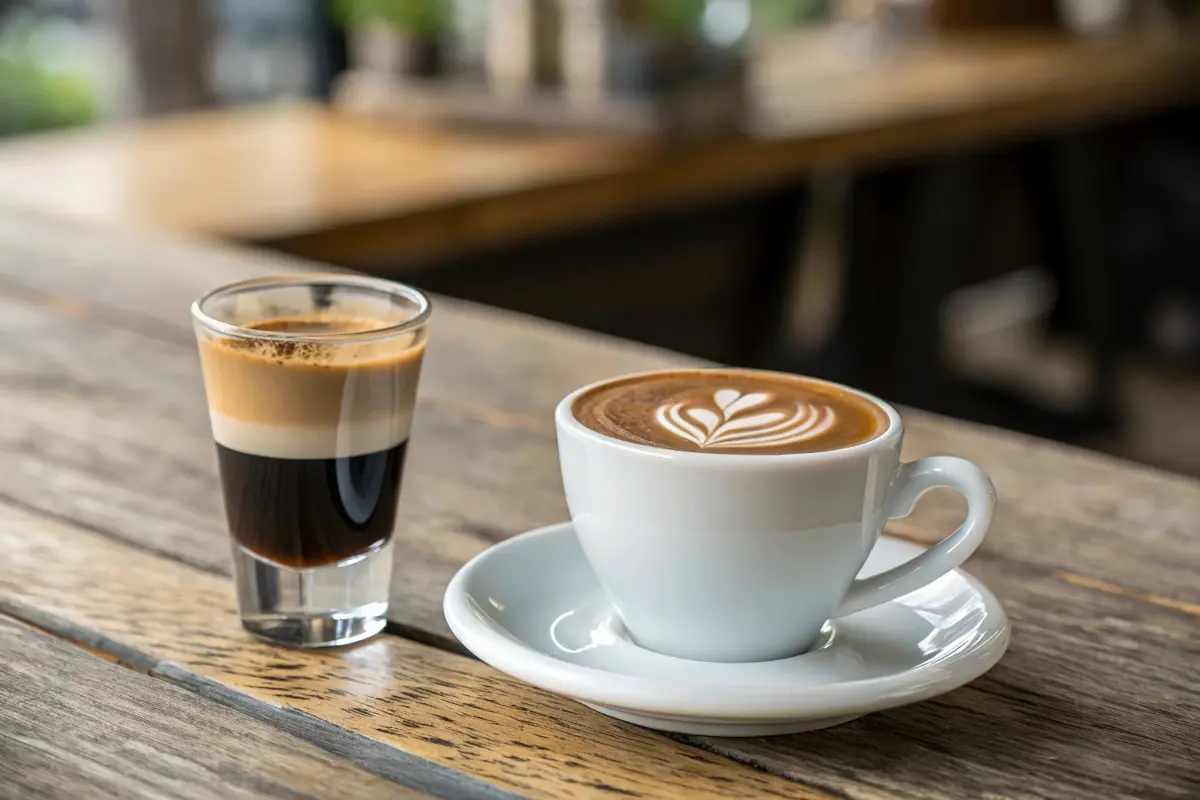Coffee drinkers often face the tantalizing question: Is a cortado the same as a flat white? While both drinks share a foundation of espresso and milk, they differ in flavor, texture, and even cultural significance. Let’s embark on a journey to uncover the nuances of these popular beverages.
Understanding Coffee Basics
The world of coffee is as complex as it is delightful. At its core, espresso-based drinks are a combination of espresso shots, milk, and foam. The proportions and preparation methods create an array of drinks, from cappuccinos to lattes. But how do cortados and flat whites fit into this intricate picture?

What Defines a Cortado?
A cortado is a Spanish-inspired espresso drink known for its simplicity and balance. The name “cortado” comes from the Spanish word cortar, meaning “to cut.” This refers to the milk cutting through the intensity of the espresso. Typically served in a small glass, a cortado consists of equal parts espresso and steamed milk. The milk is minimally frothed, making the drink smooth but not overly creamy.
Key Features of a Cortado:
- Milk-to-Coffee Ratio: 1:1 (equal parts).
- Texture: Lightly steamed milk without dense foam.
- Size: Usually 4–6 ounces, served in a small glass.
- Taste: Bold and balanced, highlighting the espresso.
What is a Flat White?
The flat white, on the other hand, has its origins in Australia and New Zealand. It’s larger than a cortado and characterized by velvety microfoam, which blends seamlessly with the espresso. A flat white typically contains a higher milk-to-coffee ratio, creating a creamier experience without the density of a latte.
Key Features of a Flat White:
- Milk-to-Coffee Ratio: Approximately 2:1 or 3:1 (more milk than espresso).
- Texture: Silky microfoam.
- Size: 5–8 ounces, served in a ceramic cup.
- Taste: Creamy with subtle espresso notes.
Key Differences Between Cortado and Flat White
Milk-to-Coffee Ratio
One of the most significant distinctions lies in the milk-to-coffee ratio. A cortado uses equal parts espresso and milk, ensuring the espresso’s bold flavor remains prominent. The flat white, however, incorporates more milk, creating a creamier and slightly milder profile.
“If coffee were a conversation, the cortado would be a sharp debate, while the flat white would be a friendly chat.” ☕
Serving Size
Size matters when it comes to coffee. The cortado’s smaller serving size (4–6 ounces) reflects its minimalist nature, offering just enough to savor its bold flavors. The flat white, ranging from 5–8 ounces, provides a more substantial, lingering experience.
Flavor Profiles
The flavor profiles differ primarily due to the milk. A cortado delivers a more intense espresso-forward taste with a touch of milk sweetness. In contrast, a flat white leans into creaminess, with the milk mellowing the espresso’s edge.
The Origins of Cortado and Flat White
The History of the Cortado
The cortado has its roots in Spain and is a staple in Spanish cafés. It’s traditionally served in a small glass to highlight its simplicity. Over the years, the cortado has traveled the globe, finding a special place in specialty coffee shops.
The Birth of the Flat White
The flat white emerged in the 1980s, with both Australia and New Zealand claiming its invention. Initially designed as a less frothy alternative to the cappuccino, the flat white quickly gained popularity for its smooth texture and balanced flavors.
Preparation Techniques for Cortado and Flat White
Equipment and Ingredients Needed
Both drinks require:
- Espresso Machine: Essential for a strong, concentrated shot of coffee.
- Milk Frother or Steam Wand: For steaming milk to the desired texture.
- Ingredients: Freshly ground coffee beans and milk (or plant-based alternatives).
Brewing a Perfect Cortado
- Pull a double shot of espresso (2 ounces).
- Steam milk lightly until it’s warm and slightly frothy.
- Combine equal parts milk and espresso in a small glass.
Crafting a Perfect Flat White
- Pull a double shot of espresso (2 ounces).
- Steam milk to create microfoam (a silky, smooth texture).
- Pour the milk gently over the espresso in a ceramic cup, ensuring the foam integrates with the coffee.
How to Choose Between a Cortado and a Flat White
Factors Based on Personal Taste
If you prefer bold coffee flavors, a cortado might be your drink of choice. For those who enjoy creamier, milk-forward drinks, the flat white offers a satisfying experience.
Matching Coffee to Mood or Occasion
Need a quick pick-me-up? Opt for a cortado. Planning to linger over coffee? A flat white’s larger size makes it ideal for relaxed moments.

Regional Variations and Adaptations
Cortado Variations Around the World
The cortado may have originated in Spain, but its global journey has seen some fascinating adaptations. In Cuba, for instance, a similar drink called “Cortadito” is sweetened with condensed milk, adding a rich, dessert-like flavor. In the United States, the cortado is often served with a creative twist, such as using oat milk for a plant-based version or adding a dash of flavored syrup.
Latin American countries often prefer their cortado slightly hotter, while European cafés stick to the original recipe of equal parts espresso and milk, focusing on the balance of taste. These regional differences highlight how the cortado adapts to the palates of coffee lovers worldwide.
How the Flat White Differs Across Countries
The flat white’s story begins in Australia and New Zealand, but its influence has spread across continents. In the United States, it is often larger and creamier than its original form, leaning closer to a latte. In the UK, the flat white stays true to its roots, maintaining a delicate balance between espresso and microfoam.
Interestingly, some specialty coffee shops in Asia serve the flat white with a hint of local flair, such as matcha-infused foam or coconut milk for a tropical twist. This evolution reflects how the flat white is both versatile and globally cherished.
Nutritional Information and Dietary Preferences
Cortado vs. Flat White: Calories and Ingredients
The nutritional difference between these two drinks is often a deciding factor for health-conscious coffee drinkers. A cortado, with its equal milk-to-coffee ratio and smaller size, typically contains fewer calories—around 50 to 70, depending on the type of milk used. The flat white, owing to its larger milk content, ranges from 100 to 150 calories.
The choice of milk can also influence the nutritional profile. Plant-based options such as almond or coconut milk reduce calorie content, while whole milk enhances creaminess but increases calories.
| Drink | Calories (approx.) | Milk Content |
|---|---|---|
| Cortado | 50–70 | Equal to espresso |
| Flat White | 100–150 | More than espresso |
Options for Lactose-Free or Plant-Based Versions
Both drinks are highly adaptable for those with dietary restrictions. Baristas worldwide now offer oat milk, almond milk, soy milk, or coconut milk as lactose-free alternatives. These options maintain the essence of the cortado or flat white while adding a slight twist to the flavor.
For instance, oat milk brings a creamy texture to a flat white, while almond milk enhances a cortado’s nutty undertones. If you’re unsure which alternative works best, ask your barista for recommendations—they’re often happy to help!
Popular Myths About Cortado and Flat White
Are They Really the Same?
One common myth is that cortados and flat whites are essentially the same. This misconception likely arises from their similar appearance and shared ingredients. However, as we’ve discussed, the drinks differ significantly in taste, texture, and size.
For instance, the cortado’s small size ensures a concentrated flavor, while the flat white’s silky microfoam creates a smoother, creamier mouthfeel. While both offer delightful experiences, they cater to different preferences.
Misconceptions About Milk Foam
Another frequent misunderstanding revolves around the foam. Many believe that both drinks require thick foam, but this is not the case. The cortado prioritizes lightly steamed milk with minimal froth, whereas the flat white demands velvety microfoam, which is an art in itself. Achieving the perfect microfoam takes skill, as the milk must be steamed to a precise temperature and consistency.
“Think of the cortado as espresso’s bold partner, while the flat white is the smooth, refined sibling.”
Ordering Tips for Coffee Lovers
How to Clearly Communicate Your Preference
When ordering a cortado or flat white, clarity is key. Not all coffee shops define these drinks the same way, so it helps to specify your preferences. For example, if you’re in a café that serves a larger cortado, you might ask for a “traditional cortado” to ensure you get the smaller, espresso-forward version.
Likewise, when requesting a flat white, mention the size and foam texture you prefer. If you’re in a country where the drink isn’t common, describing it as “a creamy espresso with silky milk” can help the barista understand your request.
Avoiding Confusion at International Cafés
Traveling can make coffee ordering tricky, especially when terms like “macchiato” or “latte” differ across cultures. The same applies to cortados and flat whites. In some regions, a flat white may be served closer to a latte, while a cortado could be presented as a mini cappuccino.
Here’s a tip: research local coffee customs before visiting a new country. Not only does this enhance your coffee experience, but it also helps you avoid surprises.
Celebrating Coffee Diversity
Ultimately, the debate between cortados and flat whites is less about which is better and more about appreciating the diversity of coffee. Each drink offers something unique, whether it’s the boldness of a cortado or the smoothness of a flat white. Coffee, after all, is about connection—both with the beverage and the community around it.
Whether you prefer the sharp, espresso-forward taste of a cortado or the creamy indulgence of a flat white, one thing is clear: there’s a coffee out there for everyone. So, why not savor both and let your palate decide?
FAQs About Cortado and Flat White
What is a cortado vs. macchiato?
A cortado and a macchiato differ primarily in their milk content and balance. A cortado consists of equal parts espresso and lightly steamed milk, offering a smooth, balanced flavor. On the other hand, a macchiato (meaning “stained” in Italian) is a shot of espresso “stained” with just a small dollop of foamed milk. The macchiato is more espresso-forward, while the cortado has a milder and creamier profile.
What is the difference between a latte and a cortado?
The difference lies in the milk-to-espresso ratio and the size. A latte contains significantly more milk than a cortado, often in a 3:1 or 4:1 ratio, and is served in a larger cup (8–12 ounces). A cortado, with its 1:1 milk-to-espresso ratio, is smaller (4–6 ounces) and delivers a more robust coffee flavor. The texture also varies: a latte is creamier with more foam, while a cortado focuses on balance with minimal froth.
Is cortado strong?
Yes, a cortado is considered strong compared to milk-heavy drinks like lattes or cappuccinos. The equal parts espresso and milk highlight the bold flavor of the coffee without overwhelming it with milk. However, the milk helps to mellow the sharpness of the espresso, making it smooth yet intense.
Are cortados and flat whites the same?
No, cortados and flat whites are different in size, milk texture, and flavor balance. A cortado has a 1:1 milk-to-espresso ratio with lightly steamed milk, while a flat white uses microfoam and a higher milk-to-espresso ratio, resulting in a creamier texture.
Can you make a cortado or flat white at home?
Absolutely! Both drinks can be made at home with an espresso machine and a steam wand. For a cortado, focus on equal parts espresso and lightly steamed milk. For a flat white, perfect your microfoam technique to achieve the velvety texture that defines the drink.
Which drink is better for coffee lovers who dislike foam?
A cortado is the better option for those who aren’t fans of foam. Its milk is only lightly steamed and lacks the dense foam characteristic of other drinks like cappuccinos or flat whites.
